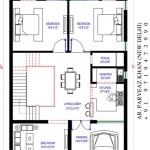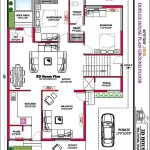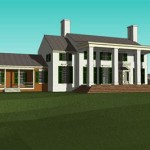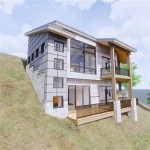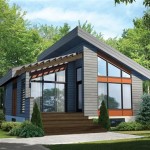Modern Contemporary House Floor Plans: A Guide to Open Spaces and Functional Design
Modern contemporary house floor plans represent a significant shift from traditional architectural layouts, emphasizing open spaces, natural light, and a seamless integration of indoor and outdoor living. These plans are characterized by clean lines, minimalist aesthetics, and a focus on functionality, catering to the evolving needs and preferences of homeowners in the 21st century. Understanding the key elements and considerations in modern contemporary floor plan design is crucial for anyone planning to build or renovate a home.
The term "modern contemporary" refers to an architectural style that blends elements of modernism (popular from the 1930s to the 1970s) with current design trends. Modernism emphasized simplicity, functionality, and the use of new materials. Contemporary design, on the other hand, constantly evolves, reflecting present-day lifestyles and technological advancements. Modern contemporary houses, therefore, are not bound by rigid rules but rather embrace flexibility and adaptability.
One of the defining features of modern contemporary homes is the open floor plan. This design approach eliminates or minimizes walls between living spaces, such as the kitchen, dining area, and living room, creating a large, interconnected area. This fosters a sense of spaciousness, encourages social interaction, and allows for flexible use of the space. However, successful implementation of an open floor plan requires careful consideration of furniture placement, zoning, and acoustics to maintain a functional and comfortable living environment.
Natural light is another critical element in modern contemporary design. Large windows, skylights, and strategically placed doors are used to maximize the entry of sunlight, creating bright and airy interiors. This not only enhances the aesthetic appeal of the home but also contributes to energy efficiency by reducing the need for artificial lighting during the day. Orientation of the house on the lot is crucial to maximize natural light exposure while minimizing unwanted heat gain, especially in warmer climates.
Key Point 1: Understanding the Principles of Open Floor Plans
Open floor plans are a hallmark of modern contemporary homes, but their successful implementation hinges on careful planning and execution. The primary goal is to create a space that feels both spacious and functional, avoiding the feeling of being an overwhelming, undefined area.
Zoning is a crucial aspect of open floor plan design. While walls are minimized, subtle visual cues can define different areas. This can be achieved through changes in flooring materials, the strategic placement of furniture, or the use of area rugs. For example, a change from hardwood flooring in the living room to tile in the kitchen can visually separate the two areas without erecting a physical barrier. Similarly, a large area rug can define the seating area in the living room, creating a distinct zone within the larger space.
Furniture plays a vital role in delineating space within an open floor plan. Large sofas or sectionals can act as dividers between the living room and dining area. Kitchen islands or peninsulas can create a natural barrier between the kitchen and the rest of the living space, providing both counter space and a visual separation. The placement of furniture should be carefully considered to ensure that it facilitates movement and flow throughout the space.
Acoustics can be a significant challenge in open floor plans. The lack of walls allows sound to travel freely, which can be disruptive, especially in homes with multiple occupants. Addressing acoustic issues requires careful planning and the use of sound-absorbing materials. Soft furnishings, such as rugs, curtains, and upholstered furniture, can help to absorb sound waves. Acoustical panels or specially designed wall coverings can also be used to reduce noise levels. The strategic placement of plants can also help to diffuse sound.
Proper ventilation is also critical in open floor plans, particularly in the kitchen area. A powerful range hood is essential to remove cooking odors and prevent them from spreading throughout the house. Adequate ventilation can be achieved through the use of windows, doors, and mechanical ventilation systems.
Key Point 2: Incorporating Natural Light and Outdoor Living
Modern contemporary design emphasizes the connection between indoor and outdoor spaces, making natural light and outdoor living areas integral components of the floor plan. Large windows, sliding glass doors, and strategically placed skylights are used to maximize the amount of natural light that enters the home.
The orientation of the house on the lot is crucial for optimizing natural light exposure. In general, south-facing windows receive the most sunlight throughout the year, making them ideal for living areas and bedrooms. East-facing windows receive morning sunlight, which can be beneficial for bedrooms and breakfast nooks. West-facing windows receive afternoon sunlight, which can lead to heat gain in the summer months. North-facing windows receive the least amount of direct sunlight and are often used for areas where consistent, diffused light is desired, such as studios or offices.
Window placement should also consider the surrounding landscape. Large windows can frame views of gardens, trees, or other natural features, creating a sense of connection with the outdoors. Privacy is also a consideration, and strategic placement of windows can help to minimize views from neighboring properties.
Outdoor living areas, such as patios, decks, and balconies, are an extension of the indoor living space in modern contemporary homes. These areas are designed to be comfortable and functional, often featuring outdoor seating, dining areas, and even outdoor kitchens. Sliding glass doors or French doors are commonly used to connect the indoor and outdoor spaces, creating a seamless transition.
The design of outdoor living areas should complement the overall aesthetic of the home. Materials used in the outdoor areas should be durable and weather-resistant, and the design should consider the climate and local environment. Landscaping plays a crucial role in creating a comfortable and inviting outdoor space. Trees, shrubs, and flowers can provide shade, privacy, and visual appeal.
In warmer climates, outdoor living areas may include features such as pools, spas, and outdoor showers. These features can enhance the functionality and enjoyment of the outdoor space.
Key Point 3: Functional Spaces and Efficient Use of Space
Modern contemporary floor plans prioritize functionality and efficient use of space. Every square foot is carefully considered, and the design is optimized to meet the specific needs of the homeowners. This often involves incorporating multi-functional spaces and utilizing storage solutions to minimize clutter.
Multi-functional spaces are designed to serve multiple purposes. For example, a guest room can also function as a home office or a hobby room. A dining area can also be used as a workspace or a gathering place for games. The key to creating successful multi-functional spaces is to design them with flexibility in mind. Furniture should be easily movable and adaptable, and storage solutions should be integrated into the design.
Storage is a critical aspect of modern contemporary design. Clutter is the enemy of simplicity and functionality, so ample storage space is essential. Built-in storage solutions, such as bookshelves, cabinets, and closets, can help to maximize space and minimize clutter. Vertical storage is also an effective way to utilize space, particularly in small homes. Shelves can be installed on walls to store books, decorations, and other items. Loft spaces can also be used for storage or as additional living areas.
Efficient use of space also involves careful consideration of the layout of the home. The placement of rooms should be logical and functional, minimizing wasted space and maximizing flow. For example, placing the laundry room near the bedrooms can make laundry chores more convenient. Positioning the mudroom near the entrance can help to keep dirt and debris from being tracked into the house.
Universal design principles can also be incorporated into modern contemporary floor plans to make the home accessible and adaptable for people of all ages and abilities. This includes features such as wider doorways, grab bars in bathrooms, and ramps or elevators for accessing different levels of the home. Universal design promotes inclusivity and ensures that the home can be enjoyed by everyone.
The integration of technology is another important aspect of modern contemporary floor plans. Smart home technology can be used to control lighting, temperature, security, and entertainment systems. This can enhance the functionality and convenience of the home, as well as improve energy efficiency.
In conclusion, modern contemporary house floor plans are characterized by open spaces, natural light, and a focus on functionality. Successful implementation of these plans requires careful consideration of zoning, acoustics, orientation, and storage. By understanding the key elements and principles of modern contemporary design, homeowners can create a home that is both beautiful and functional, perfectly suited to their needs and lifestyles.

22 House Design With Floor Plans You Will Love Simple Two Story Architectural Beautiful

Two Y Floorplan The Odyssey By National Homes Architectural Design House Plans Modern Floor

Modern Open Floor House Plans Blog Eplans Com

4 Bedroom Modern Contemporary House Plan Plans

4 Bedroom Home Design Plan 7 5x9m Samphoas Plansearch House Front Beautiful Plans Construction

Modern House Floor Plans Top 12 Features To Include

2 Story Modern House Plans Houseplans Blog Com

Modern Open Floor House Plans Blog Eplans Com

Pin By 405 446 0028 On Tiny House Inspo Manifestation In 2024 Model Plan Bungalow Style Plans One Y

Modern Open Floor House Plans Blog Eplans Com

